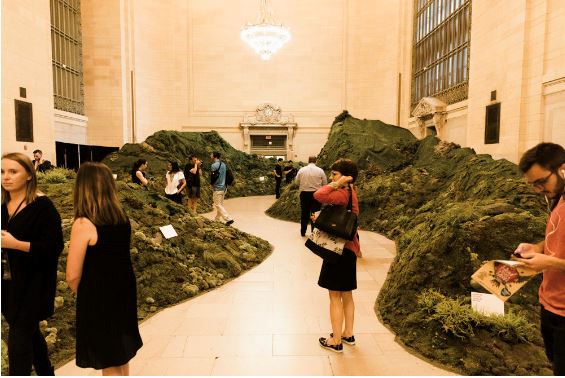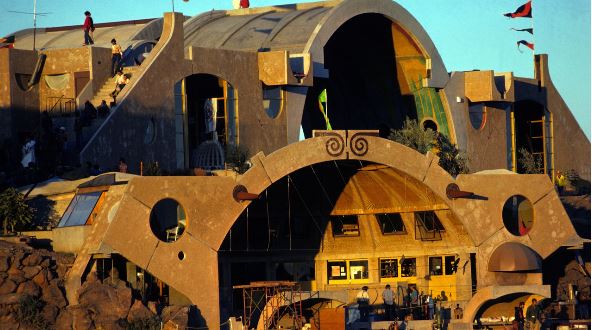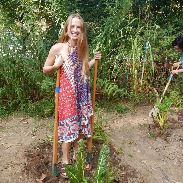An incessant mechanical beeping begins the average person’s morning and a screen filled with countless emails, likes, and news stories precedes their morning coffee. As reported by Time Magazine in “‘Forest Bathing’ Is Great for Your Health. Here’s How to Do It.”, “By 2050, 66% of the world’s population is projected to live in cities. According to a study sponsored by the Environmental Protection Agency, the average American spends 93% of his or her time indoors.” As population trends continue to rise, and more people are moving to cities, it is imperative that we not only take time to immerse ourselves in our public lands, state parks, and wilderness, but also bring the wildish nature back into our cities and ourselves to radically alter the pre-existing architectural model.
Nature-deficit Disorder (NDD) is a term used to describe human’s waning proximity to our natural world and the negative effects this is having on our physical, psychological, emotional, spiritual, and physiological well-being. Although it was only just coined by Richard Louv, author of the “Last Child in the Woods” in 2005, the deeply rooted need for connection to the natural world has been written about and understood by many texts spanning across cultures.
In, The Women Who Run With the Wolves, Clarissa Pinkola Estés, Ph.D, a practicing senior Jungian psychoanalyst, poet/cantadora, a doctorate in intercultural studies and clinical psychology, investigates our need for that which is wild. She says, “It is ironic that we have made wildlife refuges for ibis, pelican, egret, wolf, crane, deer, mouse, moose, and bear, but not for ourselves in the places where we live day after day… We fervently point out how other creatures’ natural territories have become surrounded by cities, ranches, highways, noise, and other dissonance, as though we are not surrounded by the same, as though we are not affected also.” (pg. 265). For the majority of Americans the natural and the man-made world couldn’t feel further apart, and our instinctual nature is suffering for it.
The Japanese have long practiced shinrin-yoku, shinrin meaning forest, and yoku meaning bath, or forest bathing. Forest bathing is simply a conscious returning to one’s sensory body and self within the forest in order to promote peace and health. Although the idea of tree bathing for good health may sound far fetched, the science is in and backing that forest bathing does indeed promote healthier individuals. Shrinrin-yoku has even been proven to increase our immune systems’ ability to effectively fight cancer due to the increase of natural killer cells that occurs due to forest bathing. A study published in 2010 by Environmental Health and Preventative Medicine studied the effectiveness of forest bathing and found that “The results show that forest environments promote lower concentrations of cortisol, lower pulse rate, lower blood pressure, greater parasympathetic nerve activity, and lower sympathetic nerve activity than do city environments. These results will contribute to the development of a research field dedicated to forest medicine, which may be used as a strategy for preventive medicine.”
You may be thinking, okay, I am stressed, BUT, we surely can’t all be expected to become hermits, grow long beards and live in the woods. The good news for both us, and our environment, is that we don’t have to. Innovative thinkers, creatives, artists, scientists, and collectives are exploring how to incorporate nature into our cityscapes. We’re already seeing the plant filled apartments on our newsfeeds, community gardens popping up around the corner, and installations by artists like Lily Kwong infiltrating Grand Central Station, asking people to examine and question the role of the natural within the manmade and how the two may intersect for the better.

Lily Kwong’s Immersive Installation at Grand Central Stations Vanderbilt Hall
Considering the majority of the population will be living in cityscapes, it’s crucial that we as a society remodel to lessen waste and promote positive mental health within its citizens. Arcosanti, an urban laboratory founded in the mid-sixties, coined the term, Arcology as, “Arcology is the fusion of architecture with ecology, a comprehensive urban perspective.” In the Arizona desert, they are utilizing passive climate controlled architecture, tailoring cities to people not vehicles, producing their food at the source of population, and many other simplistic and yet effective means of growing a city upwards rather than outwards, avoiding the dreaded urban sprawl. Not to mention the otherworldly aesthetics of the space. Forget the drab and dull concrete of NYC, Arcosanti looks like it belongs in a Starwars film, with its stylish and colorful usage of concrete, circular design, and view across the arid Arizona desert. Their website states, “Arcology suggests complete reformulation of how we exist within our environments – a new urban paradigm geared towards cultural evolution, frugal resiliency, and balance with nature.”

Ceramics Apse at Arcosanti
With the ever-quickening pace of our world, it is critical that we as a society prioritize our health and well being over materialism. Let’s take our scientific findings and put them into practice by incorporating the natural into our cityscapes so that tree bathing becomes the norm. It’s easy to feel overwhelmed by the prospect of changing, however in the words of Jane Goodall, “Without hope, there is no hope.” So, start an herb garden, leave the phone at home and sit in the forest (check out the Leave No Trace Principles), and get out and vote for representatives who value our Earth. Here’s to tree bathing, cultivating our wild selves, and taking a cue from Arcosanti by considering ecology and architecture as inextricably linked.
Citations
Li, Qing. “‘Forest Bathing’ Is Great for Your Health. Here’s How to Do It.” Time, https://time.com/5259602/japanese-forest-bathing/. May 1, 2018.
Kwong, Lily. “Grand Central X Highland Park.” Studio Lily Kwong, https://studiolilykwong.com/landscape.
Cosanti Foundation. “The Arcology Concept.” Arcosanti, https://arcosanti.org/project/arcology/. 2017.
Cosanti Foundation. Arcosanti, https://arcosanti.org/portfolio/ceramics-apse/. 2017.
Heiser, Christina. “How the simple act of nature helps you destress.” NBC news,
https://www.nbcnews.com/better/pop-culture/how-nature-can-solve-life-s-most-challenging-problems-ncna749361. January 7, 2018.
Park BJ, Tsunetsuga Y, Kasetani T, Kagawa T, Miyazaki Y. “The physiological effects of Shinrin-yoku (taking in the forest atmosphere or forest bathing): evidence from field experiments in 24 forests across Japan.” US National Library of Medicine National Institutes of Health, https://www.ncbi.nlm.nih.gov/pubmed/19568835. January 15, 2010.
Estes, Pinkola Clarissa. Women Who Run With the Wolves. The Random House Publishing Group, 1995.
Louv, Richard. Last Child in the Woods: Saving Our Children from Nature-deficit Disorder. Algonquin Books of Chapel Hill. 2008.
Bollinger, Chariene. “Can a Walk Through the Forest Help Prevent Cancer? 5 Amazing Forest Bathing Benefits!” The Truth About Cancer, https://thetruthaboutcancer.com/forest-bathing-benefits-cancer/. June 1, 2019.



